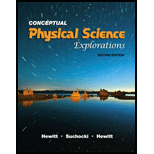
Concept explainers
The isotopes preferred in dating very old rocks.
Answer to Problem 4TE
The isotopes preferred in dating very old rocks are Uranium-238 and Uranium-235.
Explanation of Solution
Radiometric dating is the process by which the concentrations of radioactive elements in rock structures are used to determine the age of the rock. The number of decayed atoms corresponds to how long the rock has been there, and it can be found out by knowing the half-life of the radioactive isotope. Carbon-14 is useful when the dating evet lasts approximately within
Conclusion:
Therefore, the isotopes preferred in dating very old rocks are Uranium-238 and Uranium-235.
Chapter 29 Solutions
Conceptual Physical Science Explorations
Additional Science Textbook Solutions
The Cosmic Perspective
The Cosmic Perspective Fundamentals (2nd Edition)
Conceptual Integrated Science
Life in the Universe (4th Edition)
College Physics: A Strategic Approach (3rd Edition)
Cosmic Perspective Fundamentals
 College PhysicsPhysicsISBN:9781305952300Author:Raymond A. Serway, Chris VuillePublisher:Cengage Learning
College PhysicsPhysicsISBN:9781305952300Author:Raymond A. Serway, Chris VuillePublisher:Cengage Learning University Physics (14th Edition)PhysicsISBN:9780133969290Author:Hugh D. Young, Roger A. FreedmanPublisher:PEARSON
University Physics (14th Edition)PhysicsISBN:9780133969290Author:Hugh D. Young, Roger A. FreedmanPublisher:PEARSON Introduction To Quantum MechanicsPhysicsISBN:9781107189638Author:Griffiths, David J., Schroeter, Darrell F.Publisher:Cambridge University Press
Introduction To Quantum MechanicsPhysicsISBN:9781107189638Author:Griffiths, David J., Schroeter, Darrell F.Publisher:Cambridge University Press Physics for Scientists and EngineersPhysicsISBN:9781337553278Author:Raymond A. Serway, John W. JewettPublisher:Cengage Learning
Physics for Scientists and EngineersPhysicsISBN:9781337553278Author:Raymond A. Serway, John W. JewettPublisher:Cengage Learning Lecture- Tutorials for Introductory AstronomyPhysicsISBN:9780321820464Author:Edward E. Prather, Tim P. Slater, Jeff P. Adams, Gina BrissendenPublisher:Addison-Wesley
Lecture- Tutorials for Introductory AstronomyPhysicsISBN:9780321820464Author:Edward E. Prather, Tim P. Slater, Jeff P. Adams, Gina BrissendenPublisher:Addison-Wesley College Physics: A Strategic Approach (4th Editio...PhysicsISBN:9780134609034Author:Randall D. Knight (Professor Emeritus), Brian Jones, Stuart FieldPublisher:PEARSON
College Physics: A Strategic Approach (4th Editio...PhysicsISBN:9780134609034Author:Randall D. Knight (Professor Emeritus), Brian Jones, Stuart FieldPublisher:PEARSON





